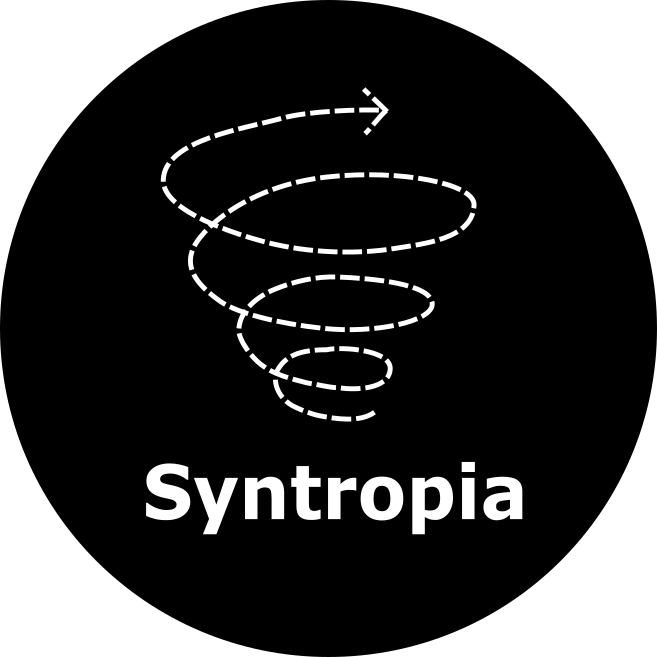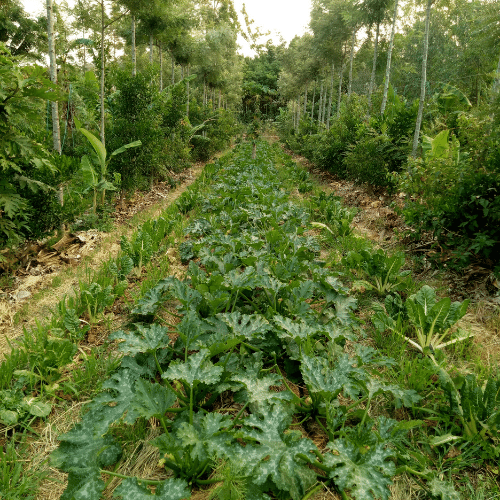What is Syntropic Farming?
Zucchini in the middle of one of Australia’s worst droughts producing a record crop
Syntropic farming comes from a very different place than conventional farming, be it organic or conventional. Syntropic Farming uses the power of ecology to drive growth, just like the great forests of the globe - there were no inputs needed for life to reach higher levels, much, much higher levels than on any farm. Of course time is a factor in this, but the point is that the forests (and savannas) are self organising systems which go through a process of species succession.
Species Succession
Species succession is something that we have known about for a long time, so what’s the big deal? The big deal is that Ernst Gotsch has decoded the process and formulated it into a management framework which is very specific and precise. He has created a system where maximum growth is achieved continuously, there are references that we take from interaction from the system and we have actions ready for every observation.
Some of the things that we understand, observe and respond to are:
Senescence
Lifecycle
Strata
We do this through the framework of a consortium, which is the interface between human management and ecology. The consortium is our control centre and the way we plant and manage a consortium determines how well the system grows.
The Macro Organism
For us to understand what is really going on in nature, we must look at it from the perspective of a macro organism. In nature, and even within our own body, nothing exists in isolation. The whole concept of anything existing in isolation is a product of the human brain, a contrived thought. The application of that thinking often has dire consequences for nature and our own health, but the good news is that we are learning more and more about this and we understand that we are actually a manifestation of community, both within and without. A very important statement made by Ernst is that “we are part of an intelligent system”. I cannot overstate how meaningful this comment is, because in the context of syntropic farming, this determines whether we can succeed or fail. Syntropic farming is 5% planting and 95% management, it is the observation, feeding back in, monitoring and feeding back in again which facilitates the process of syntropy - we are part of that intelligent system.
The macro organism is nature manifest. When plants combine the right way and move through time (and species succession), a whole, complex community is created. Plants are the primary drivers of life due to their function of combining light (photons) with carbon dioxide via the process of photosynthesis. This process creates mass, to be more specific, it creates biomass - carbon based life. From this a huge chain of positive feedbacks ensues, plants share the carbon in the form of sugars with soil life, which in return in exchange nitrogen (not exclusive to legumes). There are many other things shared as well, such as trace elements and even water. The soil life is a huge part of the macro organism and it is this web which performs a very important function which is implemented heavily in syntropic farming - the sharing of information. The complex web of life below the soil is like a kind of internet where many different signals are sent and received by relevant life forms, this is very important for species succession, where information like growth signals, ageing signals etc are shared and the soil life responds accordingly and the allocation of water and nutrients are distributed appropriately. What essentially occurs is that the most efficiently photosynthesising plants and plant groups will receive the highest support from the soil life and thus, the soil life will receive the highest return in sugars from the plant, with the result being constant strong and vigorous growth, moving through species succession. This process is all managed through the framework of the consortium.
We Humans
So it is that syntropic farming is a human enterprise. It is a framework of managing a complex macro organism to increase life - biomass (both in the form of crop and supporting organic matter) for whatever our needs determine.
For us to be effective we need to have a clear goal, there are many reasons for this, but for the sake of keeping it specific to primary production, we need to clearly know what we want. The reason why this is so important is that syntropic farming is essentially complexity management - there will be many, many more plants than in most other systems, with none of them competing, they will all be going through flux, both in groups and individually (again, the consortium is the management interface for this). There will be plants that you will need to keep or remove, depending on their age and other factors. If we do not have a clear plan as to what we want to produce, we will not be clear in our actions in management and the constant myriad of options can overwhelm us, leaving us indecisive and potentially making the wrong cuts, leaving the wrong plants or age groups and getting chaotic results - “we are part of an intelligent system”, so we must think and act intelligently, the system will only be as good as the quality of your decision making.
Management
This brings us to management. As has been stated, the framework of syntropic farming, as composed by Ernst Gotsch, is 5% planting and 95% management. Syntropic farming is nature manifest, it is miraculous, but it won’t perform miracles for you, you must perform them yourself via management.
Management largely requires taking actions to manage age groups and lifecycles which prevents senescence, manages any overpositioning and keeps the growth pulses separated by the shortest amount of time possible.
I understand that I have used some specific terminology above to help explain, hopefully it will provide an insight, but to go into the technical side is beyond the scope of this article, hopefully it can help illustrate.
**I WANT TO MAKE A VERY IMPORTANT POINT**
Whatever you do, do not become overwhelmed by the wall of complexity that you will have ahead of you if you choose to take this path.
You will be ready for everything at the time it is ready, you both grow together.
Your knowledge and capacity will increase as your system does. All you need to know in practical terms when you begin, is to know what to do in that time and place. This will see you managing your system in real time, your actions will only ever need to relate to the situation at hand, as you do this you will be learning, you will be evolving in lockstep with the system, responding only to the requirements in the present. There is no point at all worrying about what will happen in one year, two years etc, because you will never know what will actually happen and you will know at the time what to do as the system expresses - you will have evolved with the system and will respond accordingly. All you need to do is implement and manage correctly, this is all learned in any good quality syntropic farming course and you will have put all measures in place for the system to evolve the right way, but don’t worry about the future of the system, if you have done everything right in the present, the system will evolve and you with it. You will know exactly what to do in time with the evolution of the process.
We as humans often become anxious over what may be, this is one of the biggest blockages with high quality execution of syntropic farming, spending too much time worrying about what we don’t know and trying to fill those voids when everything we need to know for the present is at hand, and everything we need to know in the future will be learned through the process of doing - RELAX!
The best way to learn is by doing. Don’t let it overwhelm you, don’t give up because you don’t understand it all immediately, if you think that this is something that you can do good things with, just take a course, plant and manage!
Conclusion
Syntropic farming is very new, it challenges many of our ways of thinking, it is non reductionist or isolationist. Although inoculation is good, we don’t need to keep thinking of microbes and what types there are etc - this all evolves through species succession. All we need to do is to keep providing biomass via the process of life - everything outside of that happens as a chain reaction, this is the remarkable difference that syntropic farming brings. Syntropic farming is very, very similar to Holistically Planned Grazing, although it is a forest ecology and the other is a savanna ecology - it is management based and the increase in the mineral cycle, water cycle, energy flow and community dynamics happens as a result of increasing ecological function brought about by clear, precise and correct management.
Life begets more life, Ernst Gotsch has decoded the process and created a management framework so our human brain can understand it and our presence and actions can influence it.
All the best to you,
Scott Hall


